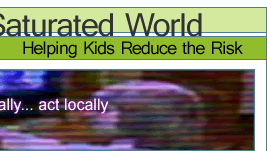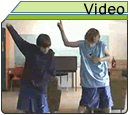|
I. Growth of Risk Science
There are many other things our children do in the course
of there lives which knowingly involve risks to their health
and well being – from skiing at Whistler, smoking, or
eating at McDonald’s. The growth of risk science was
predicated on the belief that the better we can predict a
health hazard occurrence, the more we can avoid their devastating
consequences. This is particularly true of lifestyle risks,
because the dangers arise not from eating one hamburger, or
smoking a single cigarette, but from a cumulative patterning
of voluntary behavior over time.
The reason for acknowledging, rather than avoiding risks
is that we sometimes discover simple ways of reducing them
by changing the way we think about them. For example on average
1700 children die each year in car accidents. This makes cars
one of the greatest mortality risks to children. Yet this
number has been halved since the 1970’s because we use
seat belts and car seats that helped reduce the risks associated
with cars. We benefit most from the scientific study of risks
when they provide us with a sensible way of reducing, avoiding
or limiting the risks to our kids.
II. Lifestyle Risks
III. Media As Lifestyle
Risk
a. Risks to Education
b. Risk associated
with Media and Sedentary Lifestyles
c. Risk
associated with Media and Bullying, Aggressive and Anti-Social
Behaviour
IV. Decrease in Murder
Rates
V. Bullying and Anti-social
behaviour still exists
VI. Canadian studies
VII. Media factors debate
VIIII. Parental
Regulations
IX. Alternatives: Dr.
Robinson’s study
X. North Vancouver Pilot
Project
XI. Media as part of
Peer Culture
XII. Media as part of
Family Life
XIII. Media Risk Reduction Strategy
Lifestyle Risks:
Thinking about lifestyle risks is now an important part of
contemporary parenting. As long as they are a matter of informed
consent we accept a certain degree of risk in our children’s
lives. Certainly, if we thought about all the risks we would
drown in the waves of anxiety or become exhausted by searching
for accurate information about them. So we normally tolerate
levels of anxiety about our kids as part of the normal course
of life (walking to school) and even acknowledge that our
children seek others (back country skiing; skate boarding
etc.) because they also have other benefits. The tragic backcountry
avalanche that recently killed seven students has brought
home the importance of the science of risk assessment to help
us make better everyday decisions about our children.
We could of course opt for state regulated zero tolerance.
But because lifestyle risks are voluntary and distrubted in
the marketplace, governments are increasingly reluctant to
regulate them. Even cigarettes are legal. More and more responsibility
for managing risk therefore falls upon the consumer or user.
So parents and adult guardians must wrestle with difficult
decisions daily about their children’s access to and
use of risky products and experiences: should we get a helmet
for our young skiier; should we allow our 10 year old to take
the bus home after dark? These are the choices we must make.
Yet we often find that we make these choices with very imperfect
knowledge of the real risks. And if it is hard for adults,
imagine how much harder it is for children who have even less
access to reliable risk assesments.
If adults have trouble making wise choices, then how much
harder is it for our kids. This is why when risks are hard
to estimate, we lean towards the the ‘precautionary
principle’: to err on the side of safety in situations
of uncertainty.
Media As Lifestyle Risk:
In fact, parents have been concerned about the risks associated
with new media since TV first diffused into our living rooms
after WWII. Originally announced as a window onto the world
of knowledge, the media also revealed itself to be a vast
wasteland of low brow entertainment. So there have been a
series of inquiries dating back to 1951 assessing the benefits
and risks associated with media. It will come as no surprise
to you, that there are significant health and safety risks
associated with excessive media consumption. Recently we learned
that even sitting in front of a computer screen all day, created
a risk of heart attack. So too, the flickering screen of the
Pokemon cartoon, was found to induce epileptic seizures in
13 Japanese children before it was changed. Both these risks
are relatively rare. But as we are learning with the internet,
and video games, every media has both costs and benefits:
even though the internet allows children to do their homework
on-line, it also allows them to surf for pornography, be cyber-stalked
or to be subjected to email bullying. And the
more kids use them the greater the risks can be.
The dossiers we prepared are
to help parents learn more about children’s relationship
to TV, video games or the internet which underwrites heavy
media consumption. But these reviews document two fairly well
known lifestyle risks associated with a pattern of heavy media
consumption: risks associated with media use and sentendary
lifestyles and risks associated with media use and anti-social
behaviour.
Our goals were to develop a critical media education curriculum
which gets kid to examine their media consumptin habits and
encourages them to explore alternatives that reduce the risks.
The dossiers we prepared provides parents with a research
review intended to help them in dealing with the media saturated
world. These reviews explain the research behind three fairly
wel known lifestyle risks.
a) Risks to Education
It is long been said that watching too much TV turns our
children’s brains to mush. Well this is not exactly
true, But the literature shows a clear correlation between
excessive use of media, poor reading and lower grades. The
reasons for this relationship are complex and depend on a
variety of other factors, including the child's intelligence
(Schramm 1968) and the way the family supports and encourages
reading and homework (Williams 1986; Rosengren 1989). Data
from the 2001 Youth Risk Behavior Survey of 13000 teens in
the USA provides a fairly strong indication that excessive
media consumption interferes with reading and school achievement.
Grade A students are almost twice as likely to be light viewers
as heavy viewers of TV. Grade C students are over represented
in the heavy viewing group.
b) Risks associated
with Sedentary Lifestyles
It has also been said that TV makes kids passive couch potatoes.
Although such rhetoric is unhelpful, because it blames TV
for what is a lifestyle risk, there is an element of truth
to this assertion. A number of recent studies note that obesity
is much higher among heavy TV watchers, especially for girls.
(Risk to Health Dossier) Again the YSRB study shows that there
is a general relationship between excessive media consumption
and the health risks associated with obesity and inactivity.
Such correlations we be expected for two reasons: first because
children who watch a lot of TV will be exposed to more snack
and fast food commercials. And second because in order to
watch a lot of TV these children tend to give up other kinds
of active leisure activities like sports and walking.
c) Risk of Bullying,
Aggressive and Anti-Social Behaviour
With crime rates rising from the 1950’s, youth violence
and crime have become a leading health issue in North America.
After each shooting -- Littleton, Taber and the motorway sniper
we ask ourselves an important question: are our children safe
in a world whose mean and brutal spirit is magnified on the
screen. In 2000, the Surgeon General of the USA published
a comprehensive study of youth violence adopting a public
health perspective, which ‘focuses on prevention rather
than consequences’. The Surgeon General explains, “the
concepts of risk and protection are integral to public health.
A risk factor is anything that increases the probability that
a person will suffer harm. A protective factor is something
that decreases the potential harmful effect of a risk factor.
… the public health approach to youth violence involves
identifying risk and protective factors, determining how they
work, making the public aware of these findings, and designing
programs to prevent or stop the violence.” Health
Canada has provided similar information and precautions
about the risks associated with long term violent television
viewing.
Decrease in Murder Rates:
First the good news; Murder rates have after 30 years of
climbing, peaked in 1992-93 and have begun to go down in the
USA – especially for young victims. The Surgeon General
report concludes that, “three important indicators of
the violent behavior – arrest records, victimization
data, and hospital emergency room records – have shown
significant downward trends. The total number of school killings
peaked in 1992 at 55 and have been declining since. Although
these brutal acts command the headlines, such killings account
for less than 1% of all murders of children in the United
States . School-yard shootings are a tiny fraction of the
mortality risks to children, with over 1700 dying in car accidents
and close to 30 % suffering from obesity. If we want to stop
killing our kids, we should probably ban cars and chocolate
bars, rather than guns. Which is why the Surgeon General states:
Americans cannot afford to become complacent. Even though
youth violence is less lethal today than it was in 1993, the
percentage of adolescents involved in violent behavior remains
alarmingly high’.
Bullying and Anti-social behaviour still exists:
And now the bad news; The media’s emphasis on murder
and violence provides a distorted sense of the real safety
risks that kids experience. Youth violence and bullying has
not diminished. Recent studies in the USA reveal that about
14% of children bring weapons to school, about 38% get in
fights during the year. The Surgeon General concluded: “Americans
cannot afford to become complacent. Even though youth violence
is less lethal today than it was in 1993, the percentage of
adolescents involved in violent behaviour remains alarmingly
high”.
Canadian studies:
Although the mortality rate is much lower in Canada, a similar
survey in Ontario indicated that 12.3% of students reported
assaulting someone during the past year and 10.4% carried
a weapon to school. The Ontario report suggests that fighting,
bullying and weapons in the school remain a serious issue
for teens, peaking in the 9th and 10th grades. One main effect
of media, then is that children see their own world as filled
with risks. 9% of children in the USA report feeling so afraid
that they miss school; and from the BC study 14% of children
report not feeling safe “sometimes” to “not
at all” at school. And we parents feel afraid too –
which is why we often feel better about them going to their
room to watch TV or play on their computers than go out and
play on the street.
Media factors debate:
But are they safer in these virtual playgrounds? Over the
last three decades researchers have accumulated lots of evidence
that children learn about conflict from their media –
and the more they watch and play, the more their view of conflict
reflects the mean world of terrorism and revenge that permeates
that world. For example, from the YRBS in 2001, teens who
watched more than 4 hours of TV per day, are 7% more likely
to report getting in a fight, than those that watch 1 hour
or less per day. That doesn’t mean that watching fictional
battles causes kids to feel more hostile. But it may mean
that those kids see fighting as a legitimate way of solving
social problems or have never learned that there are alternative
ways to respond to conflict. Over the population those attitudes
become magnified. We might estimate that 1,700,000 fights
every year can in part be attributed to television in the
USA.
In its review of the problem of youth violence, the Surgeon
General of the United States has said: Research to date justifies
sustained efforts to curb the adverse effects of media violence
on youths. Although our knowledge is incomplete, it is sufficient
to develop a coherent public health approach to violence prevention
that builds upon what is known, even as more research is under
way. Unlike earlier Federal research reports on media violence
and youth (National Institute of Mental Health, 1982; U.S.
Surgeon
General’s Scientific Advisory Committee on Television
and Social Behavior, 1972), this discussion takes place
within a broader examination of the causes and prevention
of youth violence. This context is vital. It permits media
violence to be regarded as one of many complex influences
on the behavior of America’s children and young people.
It also suggests that multi-layered solutions are needed to
address aggressive and violent behavior.
There has been 50 years of debate among media researchers
about the relationship between regular consumption of violent
entertainment and aggression among children and youth. The
media industries predictably claim that solid evidence concerning
the causal hypothesis is lacking and that kids know the difference
between fiction and reality. Both of these points are valid:
no-one expects ordinary kids to play Soldier of Fortune and
then go out and shoot their best friends. Sure they know it's
only a game. But with the recent murder of a Counterstrike
player in Coquitlam,
the industry also seems to be missing the point about how
media are an important aspect of the socialization of aggression
in the modern world. With children being exposed to 8000 deaths
and 100,000 violent conflicts by the time they are 12 how
could media not affect their attitudes about social conflict
and their understanding of moral constructs?
Although the scientific debate about whether media cause
aggressive behaviour continues there is little a growing consensus
that heavy consumption of violent entertainment is one of
the risk factors contributing in the development of anti-social
behaviour. “tapping into a rich but often fragmented
knowledge base about risk factors, preventive interventions
and public education, the public health perspective calls
for examinging and reconciling what are frequently contradictory
conclusions.” A recent study published in Science (Johnson
et al. ,2002) also noted that whereas 45% of the boys who
watched television more than 3 hours per day at age 14, subsequently
committed aggressive acts involving others, only 8.9%, who
watched television less than an hour a day were aggressive
later in life and that this relationship existed even after
other factors that contribute to aggression such as neighbourhood,
family dysfunction and developmental issues are accounted
for.
Parental Regulations:
Most Canadians belief that these risks are sufficient that
media violence should be regulated. The Media Q study reported
that 57% of parents see their kids as being effected by the
movies or TV they watch. In Canada, up to 70% of parents surveyed
by Media Watch had media violence as their highest regulatory
concern. Although task forces have recognized these risks
for many years, they are not politically important enough
to do something about them. Of course there was the V-chip,
but this has turned into one of the most laughable regulatory
tools ever. The video game ratings system developed by the
last BC government was one of the first to be abandoned by
the Liberals. Even the widespread concerns about internet
stalking have produced not safeguards. The reasons are, that
to do so would violate limit the industries rights to make
money off selling their legal products. The industry therefore
puts the onus for these risks on parents.
Alternatives: Dr. Robinson’s study:
(Robinson Obesity Study,
Robinson Classroom Intervention)
The alternative to this political stalemate lies in thinking
globally and acting locally argued Dr. Tom Robinson and colleagues
in San Jose who researched the risks associated with media
violence differently by applying the public health perspective
suggested by the Surgeon
General of the USA: if heavy media consumption increases
risk to children’s health and safety, then getting them
to cut back on media should reduce the risks. They therefore
developed an 18 session media education program conducted
in grades three and four classroom which encouraged children
to limit the time they spent watching TV and playing video
games. By doing so, they were able to reduce the incidence
of aggression on the playground by 25%, slow the rising tide
of obesity, and make kids ages 8and 9 feel safer and happier
at school. Our mission is to pilot test this same risk reduction
strategy in Canadian schools. The following program outlines
how we hope to challenge both children and families to make
better choices about what they do with their free time.
In the absence of legislation we feel that the Robinson study
provides one glimmer of hope. And perhaps it is time to think
globally and act locally: Given that media are being increasingly
deregulated, a community based program provides the only way
we can attempt to reduce the risks associated with media:
We are going to launch a well designed social communication
campaign that attempts to persuade kids in grade three/ four
to cut down their use of media for at least one week.
North Vancouver Pilot Project:
Inspired by Dr.
Tom Robinson's demonstration project recently undertaken
we propose a community based strategy which combines the tools
of risk communication, social marketing and media education
to reduce the developmental risks associated with heavy consumption
of media.
To achieve this goal we have adopted a social marketing approach
to community mobilization which recognizes children’s
media use is deeply embedded in the routines of family life:
to change these patterns first ask why do kids watch so much
TV and play video game?: From our study of the media saturated
lifestyle studies we conclude:
Firstly because there is pleasure in watching stories and
playing games – to ask children to change their use
of media can therefore be seen as prohibiting something that
is theirs and fun. The task must be to challenge them to change
without giving up something of value. From our surveys we
know that kids often report that watching TV and playing video
games is not their most preferred activity. In fact many of
them even report they would rather being hanging with friends
or even playing with their parents. They often choose to watch
because of circumstances in their lives make it the best way
they can balance boredom, sociality and family expectations.
Media as part of Peer Culture:
Children also consume media because they share experiences
and get peer support for doing so. Discussions of programs
and games is an important aspect of children’s peer
interactions, which like adults tend to consolidate in taste
cultures (interpretive communities). We are going to attempt
to shift the emphasis in these peer cultures and make what
you do when you don’t watch TV cool.
Media as part of Family Life:
We know that there are many circumstances in family life
that make media the easy solution to boredom and loneliness.
Children develop their habits within a family dynamic in which
parents model and negotiate limits to media consumption as
part of the family solution for a busy life. For example the
conflict over what to watch is resolved by giving kids a TV
of their own, often in their bedroom. Not only do many parents
not know what their kids are doing with media, but few families
regard TV or video games as a way of talking about moral and
aesthetic attitudes with children. The majority of parents
in our communities take a laissez faire attitude to their
children’s media use, and never bother to communicate
why playing or watching too much is not acceptable.
|





